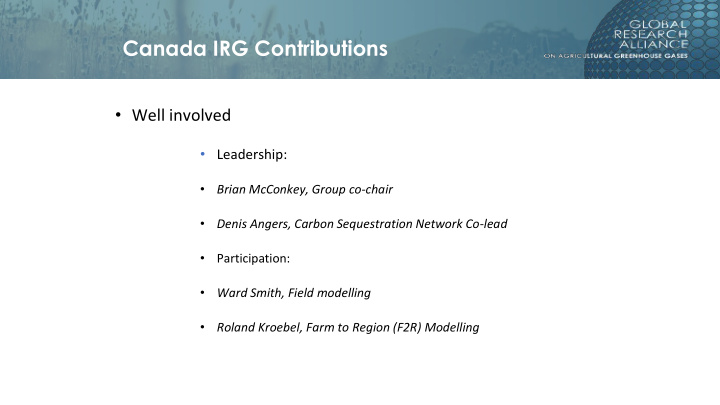



Canada IRG Contributions • Well involved • Leadership: • Brian McConkey, Group co-chair • Denis Angers, Carbon Sequestration Network Co-lead • Participation: • Ward Smith, Field modelling • Roland Kroebel, Farm to Region (F2R) Modelling
Canada Funding • No dedicated funding program for international collaboration • International collaboration within domestic Agriculture and Agri-Food Canada projects encouraged • Has provided incremental funding for Canadian involvemement to GRA projects in past • Support participation in FACCE JPI model intercomparison project involving Field Monitoring Network (then C&N Modelling Cross Cutting Group • New opportunity to apply for modest (<US$20 k) funds to link existing project to the GRA or other international initiative • Flexible • Roland Kroebel has used this mechanism to support the 2018 F2R meeting Jan 16-17, 2018
Canada NDC • 30% reduction of GHG emissions from 2005 by 2030 • Pan-Canadian Framework Plan • Carbon price • Mechanism determine provincially • Mixture of cap and trade, straight carbon tax, and convoluted carbon taxes (include GHG intensity adjustments) • Reductions in energy, industry, transportation sectors dominate • Agriculture not important part of plan • Estimated peak soil sink on agricultural lands of 13 Mt CO2 eq reached in 2006 • Biofuel from agriculturally derived feedstock is largest effective contribution from agriculture
2005-15 trend 1971-2015 trend Canada’s reported SOC change (NIR, 2017)
Canada NDC • Unclear of how emission reductions needed to reach NDC target will be obtained • Opportunities for reporting larger sink from increased C input to agricultural land • 40% increase since 2005 due to increasing crop yields, reduction in bare fallow, and change to crops with higher C inputs (especially canola) • Requires Tier 3 process modelling • Grassland soil C is “not estimated” • Increased reductions to N 2 O and CH 4 emissions? • Looking to GRA to assist with identification and adoption of beneficial management practices that will accomplish reduce agricultural emissions • International acceptance of reporting in National Inventory is essential
Recommend
More recommend